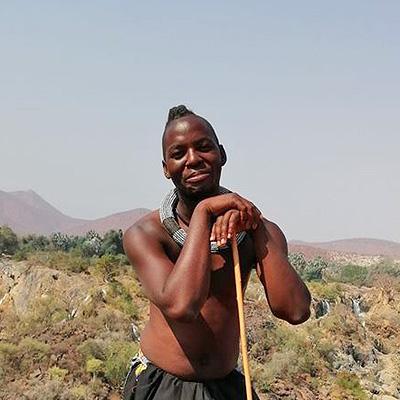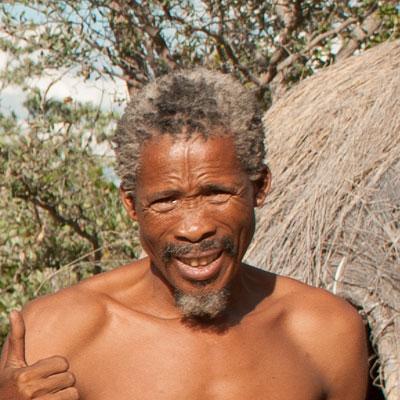Ethnology of the Mbunza
The Mbunza are one of five ethnic groups of Bantu people living in the Kavango area on both sides of the Okavango River in Namibia and Angola. Due to the fact that the Mbunza as well as the Kwangali, Shambyu, Gciriku, und Mbukushu are all living at Okavango River and are sharing quite a few cultural characteristics they are culturally merged and called Kavango.
Social life of the Mbunza
The social structures of the Mbunza are ruled by matrilineal inheritance. All socially important duties of the community are performed by relatives of the female lineage.
The most important social groups are the clan and the lineage. Within the Mbunza we find eight clans. A clan consists of members that can trace their common origin to long gone ancestors. The clan members live scattered over the whole tribal area and they do not form a territorial, political or religious entity. The name of the clan describes the origin of its members. The significance and the acceptance of the clan name is of great importance to its members.
Above the clan stands the king (Hompa) or the queen (vaHompa). King and Queen are determined by heritage and as traditional leaders they play an important political and social role in the life of the Kavango until today.
The matrilineal line constitutes the real social groupings. A Lineage consists of men and women, but only descendants of the female line count. Thus it can happen that children have a closer relationship to their uncle (the brother of their mother) than to their father.
 The Mbunza fishing in the Okavango
The Mbunza fishing in the Okavango
Religion
The Kavango believe in a mighty being named Karunga, a god that stands above all other creatures and things. In the Kavango’s believe Karunga was neither created nor born – he just exists.
The Kavango believe the Karunga manifests himself in the wind through which he demonstrates his omnipresence. The spirits of the ancestors assemble in the wind around Karunga and join him on all his journeys. Thunderstorms express Karungas anger. In former times when a hunter was followed by ever changing winds which chased all game away it was Karunga who worked against the hunter, acting on recommendation of the ancestors.
Still today the belief in Karunga and the spirits of the ancestors plays a fundamental role in the religion of the Kavangos. The belief in the ancestors’ spirit is the basis for regular prayers and sacrificing rituals for the well-being and protection of the family. The spirits play a major role when it comes to misfortune and illnesses and the healing thereof through diviners (Katemba) and medicine men (Ngana).
 Speaking to the ancestors at the shrine
Speaking to the ancestors at the shrine
History of the Mbunza
Originally the Kavango settled at the big lakes in East Africa before they stared moving southwest until they reached Mashi at the upper Kwando in today’s Zambia.
During the 16th and 18th century they immigrated into the Kavango area. After an early political separation of the Mbukushu from the rest of the immigrants, Mbunza, Kwangali, Shambyu and Gciriku split at a later stage.
Today the majority of the Kavango live directly at the Okavango River. Some have settled further south at the edge of the Kalahari basin where they share living space with the Ju/‘Hoansi and the Khwe Bushmen.
As the Kavango area was one of the last areas influenced by the structuring programs of the former colonial rulers, a large part of the traditional culture of the Kavango survived until today. Presently the Mbunza still have a versatile culture including fishing, agriculture and woodcarving and they have a strong social network to pass on their traditional knowledge.
 Preserving parts of the history by drumming and singing of old stories
Preserving parts of the history by drumming and singing of old stories
Economic life of the Mbunza
The economic life of the Mbunza and all other Kavango is dominated by fishing, land cultivation and stock farming on a subsistence basis.
The traditional fishing methods were, according to oral tradition, introduced with the immigration and can be traced back to the people who once settled in the big lake area in Central Africa. The traditional techniques have been adapted to the conditions of the Okavango area though. The names of fish, water plants, Islands and other terms of the river ecology are much more differentiated than any other aspect of life of the Kavango. The distinction between different kinds of fish traps and fish catching methods are versatile and even kids are able to identify many kinds of fish species. A lot of myths regarding the river exist and the importance of the moon as religious element in connection with the fish is emphasized upon in many rituals, festivities and medicinal dances.
Hunting used to play an important role in the past, but is prohibited today throughout the Kavango area. Nevertheless the Kavango are still familiar with the methods of hunting antelope, hippo, crocodile and even elephant. Today the cultivation of land and stockfarming are of much higher importance than hunting.
 Pounding Mahangu, the staple food of the Mbunza
Pounding Mahangu, the staple food of the Mbunza


















